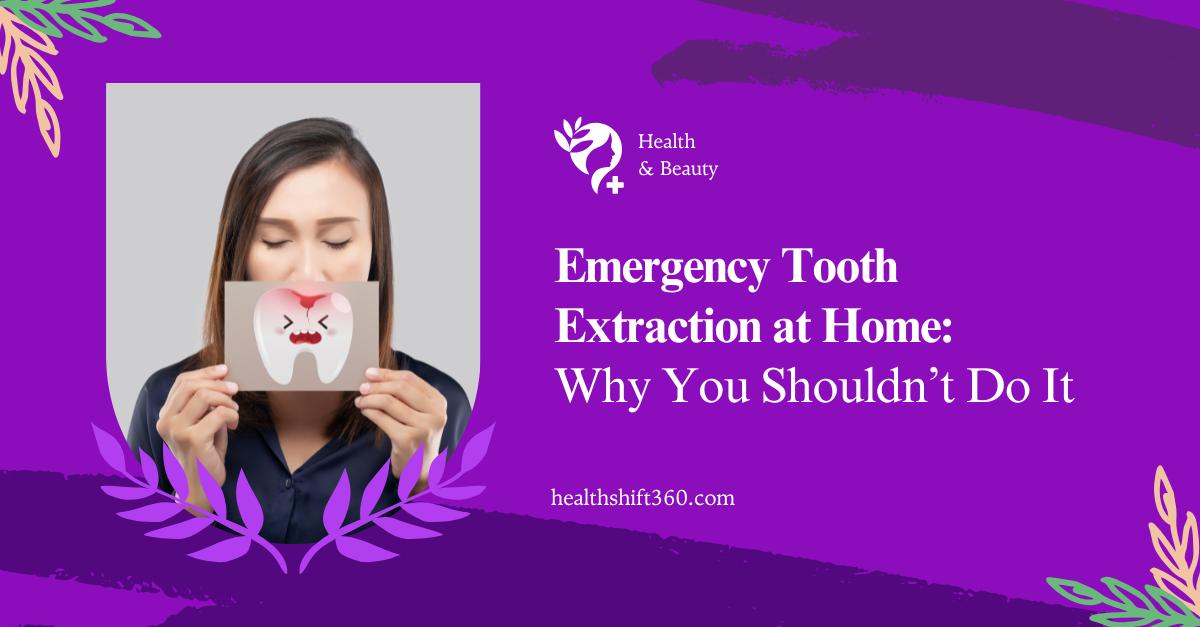When severe tooth pain strikes, it can feel like a race against time. You might be tempted to pull the tooth yourself to find quick relief. However, the risks of a DIY approach far outweigh the short-term comfort.
This guide is here to offer you expert advice, empathetic support, and clear steps for managing your pain safely until professional help is available.
Why You Shouldn’t Extract Your Tooth at Home
Attempting a tooth extraction at home might seem like a quick fix when you’re in pain, but it can lead to severe complications. Without professional care, you risk infection, nerve damage, uncontrolled bleeding, and incomplete extraction.
Risks of Home Tooth Extraction
Attempting a tooth extraction at home might seem like a quick fix when you’re in pain, but it can lead to severe complications
- Infection – Using unsterilized tools increases the risk of bacterial infection, leading to swelling, pain, and potential abscess formation.
- Nerve Damage – An incorrect extraction can damage nerves, causing numbness, tingling, or long-term sensitivity.
- Uncontrolled Bleeding – Without proper techniques and medical intervention, excessive bleeding may occur, posing serious health risks.
- Incomplete Extraction – Fragments of the tooth may remain in the gum, leading to persistent pain, swelling, and further complications.
- Permanent Damage to Surrounding Teeth and Tissues – Applying excessive force can injure nearby teeth, gums, and tissues, resulting in long-term oral health issues.
Why DIY Extraction is Dangerous
Imagine trying to fix a complex car engine with nothing but a basic wrench—this is similar to extracting your tooth without the proper tools or expertise. An incorrect extraction can lead to severe trauma, affecting not just the targeted tooth but also the surrounding structures.
Increased Risks with Wisdom Teeth
For those facing wisdom tooth pain relief, the risks become even higher. Wisdom teeth are located near vital nerves and sinuses, making improper removal highly dangerous. Any miscalculation can lead to permanent nerve damage or sinus complications.

Emergency Tooth Pain Management
Tooth pain can be unbearable, but there are several ways to manage discomfort until you can see a dentist. Understanding when to use home remedies and when to seek professional care is crucial for your oral health.
Quick Pain Relief Methods
While the idea of pulling your tooth at home might seem like a solution, there are safer ways to manage the pain until you can see a dentist.
- Cold Compress – Apply a cold pack to the outside of your cheek for 15–20 minutes to reduce swelling and numb the pain.
- Over-the-Counter Pain Relievers – Medications like ibuprofen or acetaminophen can help manage pain and inflammation.
- Clove Oil – Dab a small amount of clove oil on the affected area for temporary numbing and antibacterial benefits.
- Saltwater Rinse – Gargling with warm salt water can help reduce bacteria and soothe irritation.
these methods are temporary fixes meant for dental pain management and should not be mistaken for a complete treatment. If you’re wondering how to stop tooth pain before dentist or are looking for emergency dental care tips, remember that these remedies can only buy you time.
They do not replace a proper dental evaluation, especially if you notice any tooth infection warning signs like fever or swelling.
When to Seek Professional Help
There are clear signs that indicate you must seek professional help immediately. it is a signal that your condition might be worsening.
Signs That Require Immediate Dental Care
If you experience any of the following symptoms, seek professional help without delay:
- Uncontrollable Bleeding – Continuous bleeding that does not stop with pressure requires urgent attention.
- Severe Swelling – Swelling in the face or gums, especially if it affects breathing or vision, may indicate a serious infection.
- Fever Accompanying Tooth Pain – A fever can signal that an infection is spreading, which could lead to serious health risks.
- Persistent, Intense Pain – If your pain does not respond to over-the-counter medication or natural remedies, professional treatment is necessary.
- Signs of Infection – Symptoms of tooth infection such as pus discharge, a foul taste in the mouth, or even difficulty swallowing should never be ignored.
For those in urgent situations, consider reaching out to how to find a dentist for urgent care. Many communities offer emergency dental services that can accommodate walk-ins or provide rapid appointments.
How to Prepare for an Emergency Dentist Visit
Being prepared for a dental emergency can help you receive prompt treatment and prevent further complications.
- Find an Emergency Dentist – Research local dental clinics that offer urgent care services and keep their contact details handy.
- Document Your Symptoms – Take note of your pain level, swelling, fever, or any unusual changes to share with your dentist.
- List Medications and Medical History – Inform your dentist about any medications you’ve taken and any relevant health conditions.
- Temporary Pain Management – Use cold compresses, pain relievers, or prescribed antibiotics (if available) until you receive professional care.
Having a plan in place and knowing when to act can help prevent serious dental complications. Always prioritize your health by seeking immediate care when necessary.

Possible Alternatives to Home Extraction
If you’re in severe pain and can’t immediately access a dentist, there are alternatives that can help manage your situation without risking further harm.
One option is to use temporary filling materials available at pharmacies, which can cover a damaged area and reduce discomfort until you receive proper care.
Additionally, some dental clinics offer urgent care appointments where they can provide a temporary solution like an antibiotic treatment to control infection and ease the pain.
These professional alternatives for pain relief offer a safer route than attempting an extraction at home. Instead of risking DIY tooth extraction risks, you can reduce the pain and protect your mouth while waiting for definitive treatment from a qualified professional.
What Happens During a Professional Tooth Extraction
When you visit a dentist for an extraction, the process is carefully managed to ensure minimal discomfort. A local anaesthetic numbs the area, making the procedure as pain-free as possible.
The dentist uses specialized tools to remove the tooth while minimizing damage to surrounding tissues. For wisdom teeth removal, extra caution is taken due to their proximity to nerves and sinuses.
Any remaining fragments are removed to prevent infection or complications. After the procedure, you’ll receive aftercare instructions, including using cold compresses, taking prescribed pain relievers, and maintaining oral hygiene.
Recovery time varies, but following these guidelines is essential for smooth healing. Wisdom teeth removal recovery may take longer, requiring extra care to avoid complications.
Conclusion
While the temptation to perform an emergency tooth extraction at home may arise during intense pain, the dangers far outweigh any temporary relief. The risks of infection, nerve damage, and other serious complications make it crucial to seek professional care.
Instead of risking your health, use temporary pain management techniques and contact a dentist as soon as possible for proper treatment. Remember, your well-being is worth the wait since safety and professional care are the best remedies for a dental emergency.
By taking a careful and informed approach to managing your dental pain, you protect your overall health and ensure that when you do seek help, you receive the best care possible.
Always remember that professional dental services are the safest and most effective way to handle any dental emergency.




